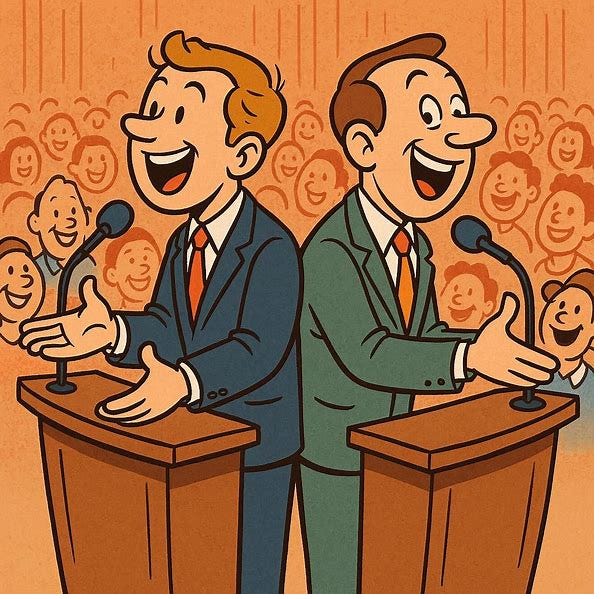In The Fed’s New Framework I began reflections on where Fed policy is going by looking at what a number of others have said, namely, Claudia Sahm,(1) Robin Brooks, Vitor Constancio, Scott Sumner, David Beckworth, Veronique De Rugy and Claudia Sahm (2)
The Fed’s New Framework 1 looked at Claudia Sahm. Today I continue with Robin Brooks and Vitor Constancio.
Brooks focused mainly on what the interest rate move (he strongly expects a reduction) means for fending off (or not) Trump pressure for one or more cuts leading to very low, ~ 1% EFFR. With little or no analysis of the economic pros and cons of a September cut, Brooks likens the situation to 2019 when the Fed was fighting once-and-future inflation. As now but with less venom, Trump called for lower rates, probably counterproductively, as the Fed resisted the political pressure. Trump was not the only person who thought the EFFR was too high and when cuts came markets were not spooked by the 2019 EFFR reduction as they would have been if there were no rationale for the reduction.
Brooks, however, interprets the 2019 cuts as tactical accommodation and thinks tactics will avoid any serious interference with Fed independence, whatever the Framework.
True to the title of the Constancio post, “FED STANCE AND FRAMEWORK REVERSALS” devotes a lot of electronic ink to the probability of a small cut in the EFFR, a cut that looked more certain the day Powell spoke as Jackson Hole than it does now after the 2.9% YoY CPI for August,
As for the new framework, Constancio sees a return to pre 2020 “Flexible Inflation Targeting (FIT) from 2020’s Flexible Average Inflation Targeting (FAIT). Specifically the 2025 Framework removes
“…following periods when inflation has been running persistently below 2%, appropriate monetary policy will likely aim to achieve inflation moderately above 2% for some time.”
While this clearly no longer promises “catch up” inflation it does not really rule it out.
And it adds language committing NOT to put on the brakes in the face of employment running above “real time assessments of maximum employment.” The U => I version of the Phillips Curve is dead but +/- I => +/- U lives on. Curiously he interprets the now discarded FAIT as a commitment (threat!) to reduce inflation to below target to achieve a backward-looking “average.” In sum FAIT (in his understanding) was never executed and its removal has no forward-looking effects.
Constancio also dances happily on the grave of the Taylor Rule, [Requiescat In Tormentis] to the tune of “Beyond the Taylor Rule” (Nakamura, Riblier and Syeinsson)., Theree the authors explain why the “FED’s policy of delayed and weaker response to the recent inflation surge was good policy. They state: “The Federal Reserve partially ‘looked through’ the post-Covid rise in inflation and ultimately managed to bring about an ‘immaculate disinflation.’”
Constancio might not agree with “immaculate.” Even though the disinflation phase was achieved without recession, essentially a first in US monetary history, he does not approve of
“…the delayed way the FED responded to the inflation spike since April 2021 (4.1%). That had to do with the misguided initial interpretation of the supply shocks that were hitting the economy and were aggravated by the unexpected invasion of Ukraine by Russia in February 2022.”[1]
But what does the new Framework imply for disequilibria arising from slow adjustment of relative prices from sectoral shocks, arguably the situation thrown up by tariffs and deportations/low immigration? Is there enough flexibility in FIT to inflate away nominal price stickiness that can cause sectoral unemployment?
Brooks does not address that question, but Constancio elsewhere does touch on the issue. The context is a comment on ECB policy, but the point is general
"The risk that a Central Bank fails to recognize the inevitable temporary nature of a supply shock inflation lies in potentially resorting to forceful or exaggerated increases in policy interest rates."
It goes beyond that. A significant sector(s)-specific supply or demand, (positive or negative) shock creates a need for realignment of relative prices. But if some nominal prices are downwardly sticky, the only way for relative prices to adjust is for other prices to rise. A central bank needs to ensure that above target infation can proceed to facilitate the adjustments taking place. Far from repressing infation in response to shocks, the central bank may need to engineer it. this post.
But for more, stay tuned for the next exciting episode of “The Fed’s New Framework!”
Image prompt: Two orators, back to back, addressing different audiences from the same platform. [I rejected the first attempt as too stern, but his goes overboard the other way!]
.
[Standard bleg: Although my style is know-it-all-ism, I do not deny that I can be mistaken or overstate my points. I also know there is an amazing range of views and experiences among readers. Bring those to bear by commenting on these posts. Both other readers and I will benefit.]
[1] Does this mean he thinks that the shift to disinflation, an increase in the EFFR, should have started with the spike? TIPS at the were still showing under-target expectations and they did not move to over-target expectations until September.


